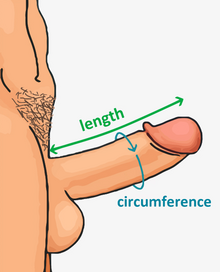This article may require copy editing for compliance with the rule Wikipedia:Manual of Style/Medicine-related articles#Cite sources, don't describe them. (September 2024) |

Human penis size varies on a number of measures, including length and circumference when flaccid and erect. Besides the natural variability of human penises in general, there are factors that lead to minor variations in a particular male, such as the level of arousal, time of day, ambient temperature, anxiety level, physical activity, and frequency of sexual activity. Compared to other primates, including large examples such as the gorilla, the human penis is thickest, both in absolute terms and relative to the rest of the body. Most human penis growth occurs in two stages: the first between infancy and the age of five; and then between about one year after the onset of puberty and, at the latest, approximately 17 years of age.[1]
Measurements vary, with studies that rely on self-measurement reporting a significantly higher average than those with a health professional measuring. As of 2015, a systematic review of 20 studies, of up to 15,521 men, who were measured by health professionals rather than themselves, concluded that the average length of an erect human penis is 13.12 cm (5.17 in), while the average circumference of an erect human penis is 11.66 cm (4.59 in).[2] A 1996 study of flaccid length found a mean of 8.8 cm (3.5 in) when measured by staff.[3] Flaccid penis length can sometimes be a poor predictor of erect length. An adult penis that is abnormally small but otherwise normally formed is referred to in medicine as a micropenis, with the cutoff usually being defined as around 3 inches (7.6 cm).

Limited to no statistically significant correlation between penis size and the size of other body parts has been found in research. Some environmental factors in addition to genetics, such as the presence of endocrine disruptors, can affect penis growth.
- ^ Stang, Jamie; Story, Mary (2005). "Ch. 1. Adolescent Growth and Development" (PDF). In Stang J, Story M (ed.). Guidelines for Adolescent Nutrition Services. University of Minnesota. p. 3. Retrieved 26 November 2012.
- ^ Veale, David; Miles, Sarah; Bramley, Sally; Muir, Gordon; Hodsoll, John (June 2015). "Am I normal? A systematic review and construction of nomograms for flaccid and erect penis length and circumference in up to 15 521 men: Nomograms for flaccid/erect penis length and circumference". BJU International. 115 (6): 978–986. doi:10.1111/bju.13010. PMID 25487360.
- ^ Cite error: The named reference
pmid8709382was invoked but never defined (see the help page).